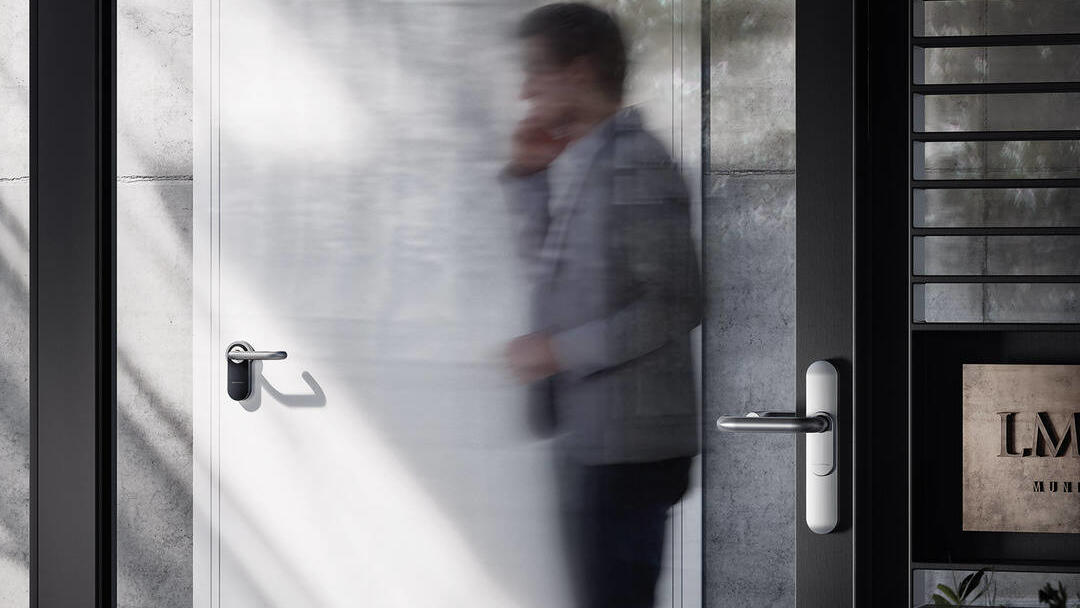
Door lock types: How to choose the right one
As a core security component in all premises and facilities, we use door locks every day. You will find below the eight most common door lock types with their respective functions in detail.
Content:
- Which door lock is suitable for different types of door?
- Mortise lock
- Metal frame lock
- Profile cylinder lock
- Padlock
- Rim lock
- Curved bolt lock
- Warded lock
- WC lock/bathroom lock
- What makes SimonsVoss different?
Which door lock is suitable for different types of door?
Door locks form an important, integral part of security in all buildings, regardless of their use, and we use them virtually every day. There is a wide range of door lock types, varying significantly in both their design and function, as well as their ability to provide high level security.
Some of the most common types of door locks are padlocks, mortise locks and locks for metal frame doors. Mortise locks are the often-used locks for interior doors, while metal frame locks are mainly used for gates and portals, while padlocks are suitable for barriers, lockers or cabinet doors.
In the digital age, the role of digital identification media is expanding, offering numerous advantages over traditional manual locks. The variety of digital lock types is clearly as extensive as their appearance and modes of operation.
To gain a better understanding of the various door lock types, we have provided here detailed explanations of the eight most common models along with their specific advantages and applications.
Overview of the eight most common door lock types

Mortise lock
The mortise lock is a common lock type that is installed in flush, rebate or metal frame doors. It uses different locking systems depending on the design, including tumbler, warded and profile cylinder locking systems.
The locking device is embedded into the door leaf in a lock pocket and consists of several components, including the lock case, lock cover and the latch. In the case of this lock type, only the latch bolt (also known simply as the latch) and the bolt block are visible from the outside. These locks are screwed to the door using what is known as a faceplate, a vertical metal strip. The door is locked by pulling the door closed or turning the key in the lock case. The lock mechanism is often combined with door handles or levers. The locking device is recessed into the door leaf and requires a cut-out, which may weaken the material in the area surrounding the lock pocket.
Advantages:
Mortise locks are very often used as a simple locking device in house and apartment doors but are also used in outdoor areas in larger, commercial premises.
Besides being easy to fit, they also offer the advantage of relatively strong burglary resistance since they cannot be unscrewed easily. On some models, a multi-point locking system is also possible in which several dead bolts engage in the strike plate, making it difficult to lever and drill the door open. It is also possible to include anti-picking or anti-drilling protection.
Disadvantages:
One drawback to the mortise lock is the inconvenience of losing keys since the lock then must be replaced completely in cases of need. Moreover, basic tools can be used to tamper with this lock and open the door.
- Office Buildings: Intelligent handles provide secure access to office spaces, conference rooms, and other restricted areas within corporate environments.
- Hospitals and Healthcare Facilities: These handles help control access to patient rooms, laboratories, pharmacies, and other sensitive areas in healthcare settings, ensuring patient privacy and safety.
- Educational Institutions: Schools, colleges, and universities use intelligent handles to regulate access to classrooms, libraries, laboratories, and administrative offices, enhancing campus security.
- Local Authorities: Government buildings, military bases, and law enforcement agencies utilise intelligent handles to protect classified information and secure critical infrastructure.
- Hotels and Hospitality: Intelligent handles are employed in hotels, resorts, and hospitality venues to manage guest room access, ensuring privacy and safety for guests and staff.
- Industrial Facilities: Factories, warehouses, and manufacturing plants utilise intelligent handles to regulate access to production areas, equipment rooms, and storage facilities, improving safety and security protocols.
- Transportation Hubs: Airports, train stations, and bus terminals employ intelligent handles to control access to restricted areas, such as baggage handling areas, control rooms, and maintenance facilities.
- Data Centres and IT Facilities: Data centres and IT facilities use intelligent handles to safeguard server rooms, network closets, and sensitive equipment, protecting valuable data and infrastructure from unauthorised access.
- In fact, they can be used anywhere where users want to move a way from using outdated key security and start implementing up to date digital locking security.
What type of doors can these handles be fitted on?
Smart handles can be fitted on various types of doors, offering versatility and security. Depending on the chosen model, they can be installed on:
- - UPVC Doors
- - Timber and Wood Door
- - Aluminium and Glass Doors
- - External Doors
Suppliers typically offer ranges tailored to different security levels, ranging from low-priority internal door installations to heavy-duty options. The most robust digital door locks are designed to withstand most attacks and provide reliable service for many years, even when installed on external doors or subjected to heavy traffic or extreme use.
Pros and Cons of Door Digital Handles
Pros:
- Flexibility: Digital handles offer greater flexibility in terms of access control, allowing administrators to easily grant or revoke access rights remotely.
- Convenience: Users can gain access using various authentication methods such keycards, or smartphone apps, eliminating the need for physical keys.
- Enhanced Security: Digital handles often feature advanced security features such as encryption, tamper detection, and audit trails, reducing the risk of unauthorised access and enhancing overall security.
- Scalability: These handles are easily scalable, allowing organisations to add or remove access points as needed without significant infrastructure changes.
- Remote Management: With digital handles, administrators can remotely monitor and manage access control systems, saving time and resources compared to manual key management.
- Integration: Many digital handle systems integrate seamlessly with other security systems such as CCTV cameras and alarm systems, providing a comprehensive security solution.
- Customisation: Digital handles offer customisable access control settings, allowing organisations to tailor access permissions based on user roles and schedules.
Cons:
- Initial Cost: Digital handle systems typically require a higher initial investment compared to traditional lock and key systems, including the cost of hardware, installation, and software.
- Learning Curve: Users may require training to familiarise themselves with the operation of digital handles and access control systems, which can increase implementation time and costs.
- Compatibility Issues: Integrating digital handle systems with existing infrastructure or legacy systems may present compatibility challenges, requiring additional time and resources for implementation.
What are the projected savings of using SimonsVoss Smart Door Handles?
We’ve worked out a simple example for you to understand the long terms savings.
Electronic mag locks not only consume electricity constantly but also rack up a hefty bill, with a yearly cost of £339.45 per lock.
Electric Mag Locks:
- - Uses 0.25A on a 24VDC power supply. This equates to 0.0006 kilowatts or 0.144kWh over 24 hours. Typical unit rate for 1 kWh in England was £0.27, so the cost for 1 day is £6.84.
- - £6.84 x 0.144kWh = £0.98 per day
- - £ 0.98 x 365 = £357.70 per year for each electronic mag lock.
In contrast, SimonsVoss SmartHandle AX operates on four cost-effective CR2450 lithium batteries, ensuring your peace of mind for up to 7 years at a mere £1.28 per year.
- - 4 CR2450 lithium batteries at £8.90
- - Standby battery life is 10years – our research shows our products are in standby mode for 96.6% of the time.
- - So let’s say you have a high usage door and only get 7 years battery life, it means it’s going to cost £ 1.28 per year! £ 8.99/7 = £ 1.28
- - You'll save a substantial £338.17 per year, per door, all while maintaining top-tier security.
Why Trust SimonsVoss?
- German-made quality – Founded in 1995
- Installed over 2,500,000 locking devices and 7,000,000 transponders
- ISO 9001/14001 Certified
- More than 25 years ago, we paved the way with a revolutionary idea of digital locking technology.
- Thanks to our unwavering demand for high quality, technology and reliability, we always find a sustainable answer to individual security requirements.
Intelligence at the handle represents a paradigm shift in access control technology, empowering organisations and individuals to enhance security, streamline operations, and adapt to evolving security needs. By embracing electronic door handles, you can unlock a world of possibilities and take control of your security with confidence. Trust SimonsVoss to make to make a smooth transition to better security and access control.
